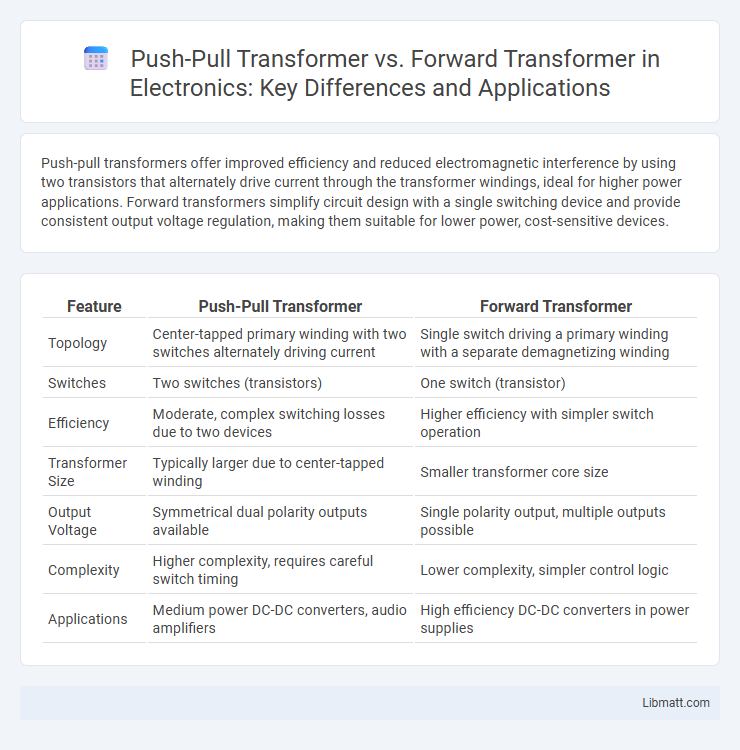Push-pull transformers offer improved efficiency and reduced electromagnetic interference by using two transistors that alternately drive current through the transformer windings, ideal for higher power applications. Forward transformers simplify circuit design with a single switching device and provide consistent output voltage regulation, making them suitable for lower power, cost-sensitive devices.
Table of Comparison
| Feature | Push-Pull Transformer | Forward Transformer |
|---|---|---|
| Topology | Center-tapped primary winding with two switches alternately driving current | Single switch driving a primary winding with a separate demagnetizing winding |
| Switches | Two switches (transistors) | One switch (transistor) |
| Efficiency | Moderate, complex switching losses due to two devices | Higher efficiency with simpler switch operation |
| Transformer Size | Typically larger due to center-tapped winding | Smaller transformer core size |
| Output Voltage | Symmetrical dual polarity outputs available | Single polarity output, multiple outputs possible |
| Complexity | Higher complexity, requires careful switch timing | Lower complexity, simpler control logic |
| Applications | Medium power DC-DC converters, audio amplifiers | High efficiency DC-DC converters in power supplies |
Introduction to Transformer Topologies
Push-Pull transformers utilize two transistors that alternately drive current through the primary winding, enabling efficient power transfer with reduced core saturation and lower electromagnetic interference. Forward transformers operate with a single switch and transfer energy directly to the secondary winding during the on-time, offering simpler control and reduced component count but typically less efficiency at high power levels. Your choice between push-pull and forward topologies depends on power requirements, efficiency targets, and design complexity in transformer-based power supplies.
Overview of Push-Pull Transformer
The Push-Pull Transformer design features two complementary windings that alternately "push" and "pull" current through the load, enabling efficient power transfer and reduced core saturation. This configuration improves energy conversion efficiency by minimizing switching losses and electromagnetic interference compared to Forward Transformers. Its ability to handle higher power levels makes it ideal for applications requiring robust performance and thermal management.
Overview of Forward Transformer
The Forward Transformer architecture enables parallel processing of sequential data by utilizing self-attention mechanisms and feed-forward layers without relying on recurrent connections. It improves training efficiency and scalability compared to traditional recurrent neural networks by handling entire sequences simultaneously. This design enhances performance in natural language processing tasks by capturing long-range dependencies and contextual information effectively.
Core Operating Principles
Push-Pull Transformers operate by alternately driving two halves of the primary winding, creating a magnetic flux that induces voltage in the secondary winding with high efficiency and balanced load distribution. Forward Transformers utilize a single switch to transfer energy directly from the primary to the secondary during the switch's on-time, relying on the transformer's core to store and transfer energy efficiently. The push-pull design inherently minimizes core and copper losses through symmetrical operation, while forward transformers offer simpler control and lower voltage stress on components.
Efficiency Comparison
Push-Pull Transformers demonstrate higher efficiency compared to Forward Transformers by utilizing a bidirectional energy flow mechanism that reduces core losses and improves voltage regulation. The Push-Pull topology supports better power density and lower switching losses due to balanced magnetic flux, making it suitable for medium to high power applications. In contrast, Forward Transformers often exhibit higher conduction losses and less effective utilization of the magnetic core, resulting in comparatively lower overall efficiency.
Circuit Complexity and Design
Push-Pull Transformers exhibit lower circuit complexity due to their balanced operation, reducing the number of windings and associated components compared to Forward Transformers. Forward Transformers require more intricate design with additional windings and snubber circuits to manage voltage spikes and ensure efficient energy transfer. The simplicity of Push-Pull design enables easier thermal management and compact integration, while Forward Transformers offer precise voltage control at the cost of increased design complexity.
Cost and Component Analysis
Push-Pull Transformers typically offer higher efficiency and lower electromagnetic interference due to their balanced winding structure, which reduces core losses and optimizes copper utilization, resulting in moderate component costs. Forward Transformers, while simpler and often cheaper in components such as cores and windings, can experience higher losses and require additional filtering, increasing overall system cost and complexity. The push-pull design's improved power handling can justify its higher initial cost through better performance and reduced thermal management expenses.
Typical Applications
Push-Pull Transformers are commonly used in audio amplification and DC-DC converter circuits due to their efficient power handling and reduced distortion characteristics. Forward Transformers find typical application in switch-mode power supplies and power distribution systems where high-frequency operation and compact design are essential. Both transformer types serve critical roles in power electronics, optimized respectively for signal fidelity and energy transfer efficiency.
Advantages and Disadvantages
Push-Pull transformers offer higher efficiency and reduced electromagnetic interference compared to Forward transformers, making them ideal for power supplies requiring better noise performance and energy savings. However, Push-Pull designs tend to be more complex and costly to implement, while Forward transformers are simpler, more compact, and less expensive, suitable for lower-power applications. Your choice depends on balancing efficiency needs against cost and design complexity in your specific power conversion project.
Choosing the Right Transformer for Your Application
Selecting the appropriate transformer hinges on the specific requirements of your application: Push-Pull Transformers offer efficient power conversion and reduced electromagnetic interference, ideal for medium power applications demanding compact size and high frequency operation. Forward Transformers excel in simple design and cost-effectiveness for low to medium power scenarios, providing straightforward voltage regulation and continuous energy transfer. Prioritize parameters such as power rating, efficiency, size constraints, and switching frequency to determine whether Push-Pull or Forward Transformer aligns better with your project's electrical and thermal management needs.
Push-Pull Transformer vs Forward Transformer Infographic

 libmatt.com
libmatt.com